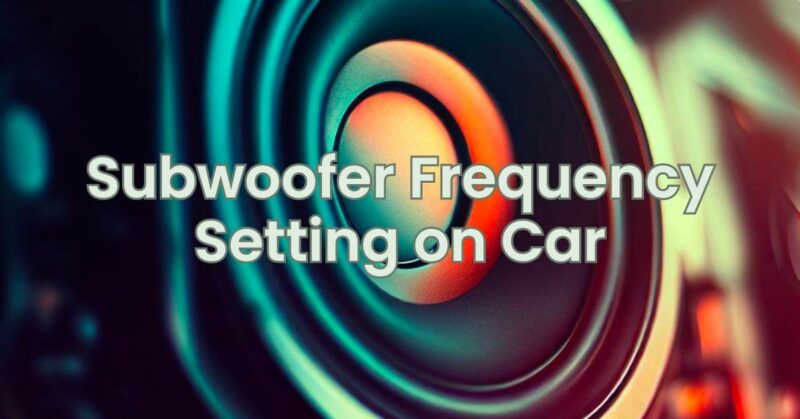The best subwoofer frequency setting for your car will depend on a number of factors, including the size of your car, the type of music you listen to, and your personal preferences. However, as a general rule of thumb, you should aim for a crossover frequency of around 80 Hz. This means that the subwoofer will only be responsible for frequencies below 80 Hz, while the other speakers in your car will handle frequencies above 80 Hz.
Here are some things to keep in mind when setting the crossover frequency for your subwoofer:
- The size of your car: If you have a small car, you may want to lower the crossover frequency to around 70 Hz. This will help to prevent the subwoofer from overpowering the other speakers in your car.
- The type of music you listen to: If you listen to a lot of music with a lot of bass, you may want to raise the crossover frequency to around 90 Hz. This will help to prevent the subwoofer from distorting the sound.
- Your personal preferences: Some people prefer a lot of bass, while others prefer a more balanced sound. Experiment with different crossover frequencies until you find one that sounds best to your ears.
Here are some tips for setting the crossover frequency for your subwoofer:
- Start by setting the crossover frequency to 80 Hz.
- Play some music and listen to the sound quality.
- If the sound is too muddy, lower the crossover frequency.
- If the sound is too thin, raise the crossover frequency.
- Repeat steps 3 and 4 until you find a crossover frequency that sounds best to your ears.
If you are still having trouble setting the crossover frequency for your subwoofer, you may want to consult with a professional car audio installer. They can help you choose the right crossover frequency for your car and your listening preferences.
Here are some additional tips for improving the sound quality of your car audio system:
- Upgrade your speakers: Speakers are the most important component in any audio system, so it’s worth investing in a good pair. When choosing speakers, consider the size of your car, the type of music you listen to, and your budget.
- Get a better amplifier: The amplifier is responsible for powering your speakers, so it’s important to get one that is powerful enough to drive your speakers to their full potential. If you’re not sure what size amplifier you need, consult with an audio specialist.
- Use high-quality cables: Cables can make a big difference in the sound quality of your audio system. When choosing cables, look for ones that are made with high-quality materials and that are properly shielded.
- Place your speakers properly: The placement of your speakers is important for achieving the best sound quality. For the best results, place your speakers at ear level and angle them slightly towards your listening position.
- Treat your car acoustically: If you have a lot of echoes or unwanted reflections in your car, you may want to consider treating your car acoustically. This can be done by using acoustic panels, rugs, or other materials to absorb sound waves.
- Calibrate your system: Once you’ve upgraded your speakers, amplifier, and cables, it’s important to calibrate your system. This will ensure that all of your speakers are playing at the correct volume and that the sound is evenly distributed throughout your car. Most receivers come with a built-in calibration microphone that can be used to do the job.
- Upgrade your source material: The quality of your source material can also affect the sound quality of your audio system. If you’re listening to compressed audio files, such as MP3s, you may want to consider upgrading to lossless audio files, such as FLAC or WAV.
By following these tips, you can improve the sound quality of your car audio system and enjoy your favorite music, movies, and TV shows in stunning sound.


